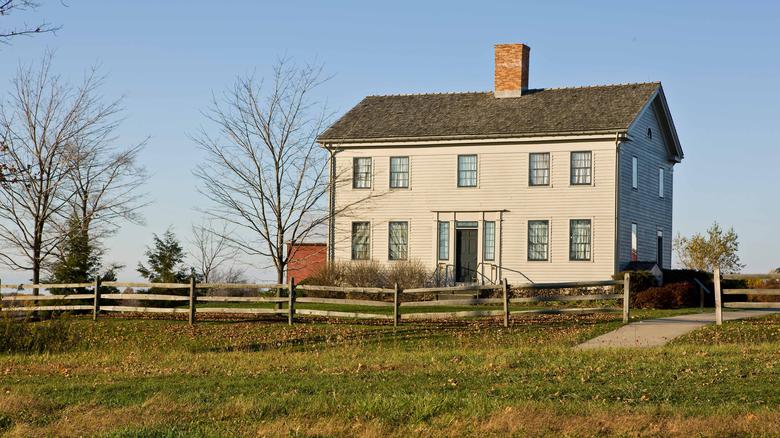The Kirtland Temple is a sacred place. Several events that took place there—such as the appearance of the Savior to accept the temple and the delivery of priesthood keys by Moses, Elias, and Elijah—are well known. Other activities that took place in the Kirtland Temple are less well known but are still important to understanding the Saints’ temple experiences and what they considered sacred. Today’s Latter-day Saints will associate some of these events and activities with temples; others they might not.
Just as the temple is central to the lives of Latter-day Saints today, the Kirtland Temple was central to the lives of the early Saints. Lucy Mack Smith recalled that even during its construction, the Kirtland Temple was the “main spring to all our thoughts.”
When the Lord commanded the Saints to build a temple in Kirtland, He taught them about the building’s purpose. “Establish a house,” He directed, “even a house of prayer, a house of fasting, a house of faith, a house of learning, a house of glory, a house of order, a house of God” (D&C 88:119). Joseph Smith echoed this language three years later in the temple’s dedicatory prayer (see D&C 109:8).
In fulfilling the dedicated purposes of the Kirtland Temple, the Saints engaged in activities that today are typically associated with three kinds of buildings—temples, chapels, and schools. In so doing, the Saints were learning that all endeavors are sacred in a community laboring to build a stake of Zion.
Some of the ways in which the Saints fulfilled the temple’s divine purposes are shown below.
Photographs courtesy of Community of Christ.
It was a house of fasting.
On the first floor of the Kirtland Temple, the Saints gathered on Thursday evenings for prayer meetings. On the first Thursday of the month, a fast was celebrated during a worship service from 10:00 a.m. to 4:00 p.m. Much of these meetings, according to Eliza R. Snow, were spent in “prayer, with testimonies of manifestations of the power of God, and with exhortations to faithfulness.”

It was a house of faith.
The Saints ascended these stone steps to the temple numerous times a week to express their faith in various ways. As a result, the temple was in continual use. In addition to the Sabbath worship services and Thursday prayer meetings, the quorums of elders, high priests, Seventies, and Apostles and the high council used various spaces in the temple during weekly meetings in the evenings. On weekdays, more than a hundred students entered the temple for scholastic study. On Sunday evenings, a choir school was held to practice worship service accompaniment.

It was a house of learning.
In these rooms on the third floor of the temple, as many as 140 Saints came together during weekdays to study a variety of subjects, including reading, writing, history, and geography. Here Joseph Smith and others studied Hebrew grammar to aid their understanding of the Old Testament. The second floor was also used primarily as a space for instruction.

It was a house of order.
The beautiful tiered pulpits on the east and west sides of the first and second floors of the temple impressed upon the minds of the Saints the orders and offices of the priesthood. In the years leading up to the dedication of the Kirtland Temple, the offices and quorums of the priesthood were organized. The Saints learned that these offices and quorums were central to establishing Zion and her stakes. Order in the temple was also manifest in the way the Saints carried themselves. Prior to the temple’s dedication, a council, including Joseph Smith and other Church leaders, created “rules and regulations” to govern public worship in the temple.

It was a house of glory.
At the top of these stairs, in the rooms on the third floor of the temple, many Saints participated in ordinances preparatory to taking the restored gospel of Jesus Christ to all the earth. During the administration of these ordinances, Joseph Smith’s scribe noted, “The power of the Highest rested upon us; the house was filled with the glory of God.” These ordinances, along with a dramatic outpouring of the Holy Spirit and a solemn assembly held several days following the temple’s dedication, fulfilled the Lord’s promise to endow the Saints “with power from on high” (D&C 95:8).

It was a house of God.
Intricate woodcarvings adorning window trims, columns, and pulpits reflect the desire of those who labored on the temple to give their very best to the Lord. In extreme poverty, the Saints labored to construct and furnish a building worthy of the title “house of the Lord.” A few days after the dedication of the temple, the Lord appeared “standing upon the breastwork” of the ornate pulpits on the first floor of the temple and exclaimed to Joseph Smith and Oliver Cowdery, “I have accepted this house, and my name shall be here; and I will manifest myself to my people in mercy in this house” (D&C 110:2, 7).
.jpg)

